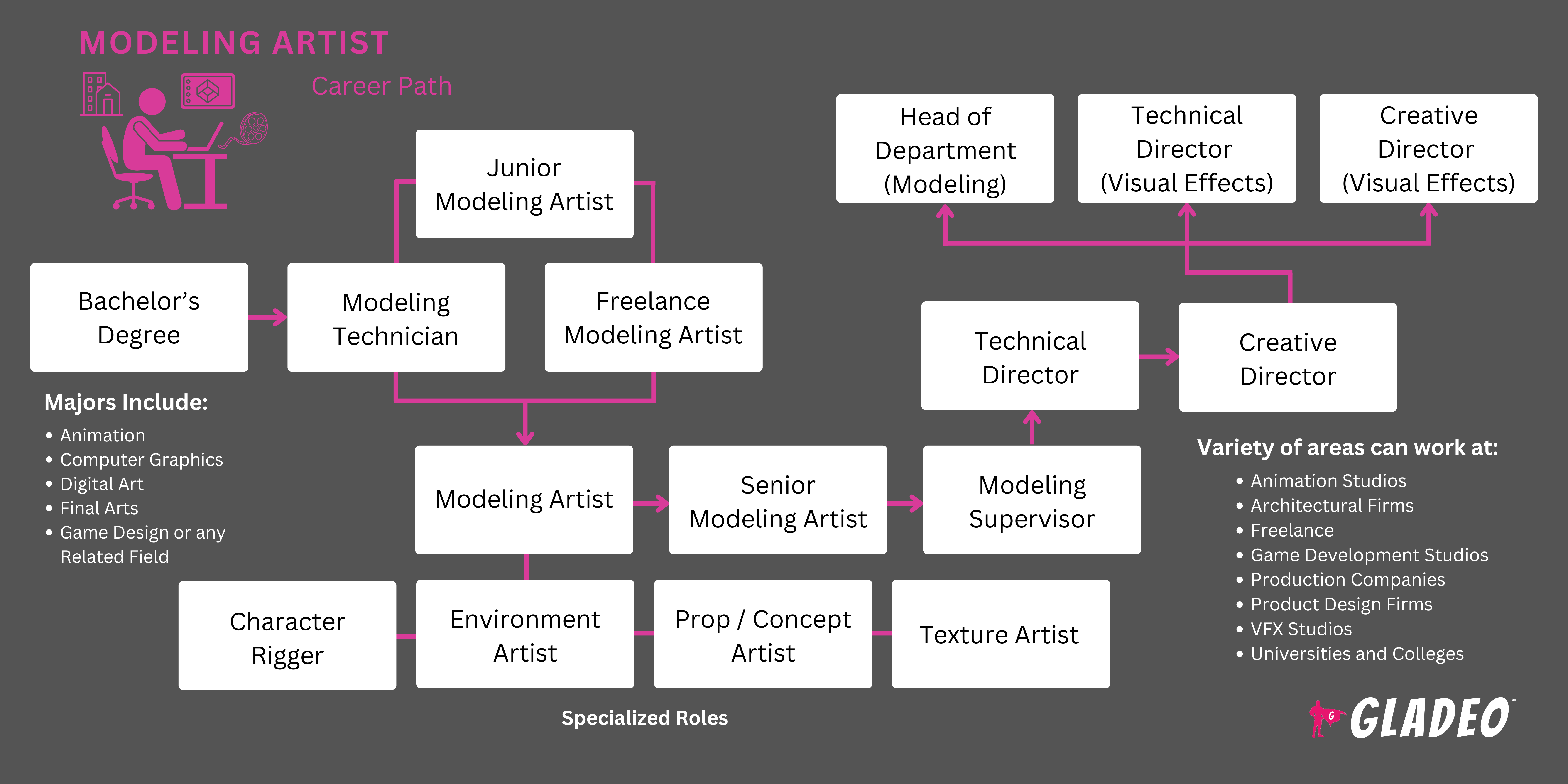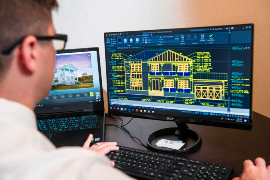Spotlights
3D Modeler, 3D Artist, 3D Visualizer, Digital Sculptor, Game Asset Artist, Character Artist, Environment Artist, Texture Artist, CAD Designer, Concept Artist, Visual Effects (VFX) Artist, Simulation Modeler
Modeling Artists are the creative minds behind the 3D models used in product designs, video games, films, and other industries. Using digital sculpting and modeling software, these artists craft detailed outlines for all sorts of objects, characters, creatures, buildings, and simulated environments.
They often start with sketches, then proceed through development stages such as digital sculpting, texturing, shading, and rigging (i.e., making digital skeletons that control the movement of a 3D model). In some cases, Modeling Artists even create physical prototypes or scale models using materials like clay, wood, or plastic before translating those designs into digital formats.
Once the digital models are ready to go, they’re passed to animators or project directors. These team members flesh out the designs and make sure they function as intended in whatever media they are made for, such as games or movies!
- Creative fulfillment in making models that become parts of films, games, and other media
- Opportunities within many different industries
- Industry recognition for contributing to the success of high-profile projects
- Collaborating with animators, directors, and designers
Working Schedule
Modeling Artists typically work full-time, often with overtime needed to meet deadlines. They may work in studios, design firms, or remotely from home. Some work in a freelance or contract capacity.
Typical Duties
- Participate in design reviews. Provide input on visual development and model specifications
- Create detailed, accurate, high-resolution 3D models for characters, props, buildings, products, or environments based on concept art and design briefs
- Potentially sculpt hard-surface models using clay, wood, or other materials
- Retopologize models to optimize for animation and performance
Create UV maps (projecting 3D model surfaces to 2D images) and apply textures to models, ensuring seamless integration with other visual elements - Bake textures, normal maps, and ambient occlusion for enhanced realism
- Note, baking in 3D modeling is the process of transferring detailed information, like textures and lighting, from complex models to simpler ones
- Use industry-standard software such as Maya, Blender, ZBrush, and 3ds Max to sculpt, model, and refine digital assets
- Collaborate closely with animators and other artists to ensure models are ready for the next phase
- Troubleshoot issues related to model integration and performance
- Ensure models adhere to technical constraints like polygon count and texture memory without sacrificing quality
- Revise models based on feedback from directors, clients, or QA teams
- Integrate models into game engines or rendering software, ensuring compatibility with the project pipeline
Additional Responsibilities
- Create detailed documentation for models, including technical specifications and artistic intent
- Train and mentor new artists
- Engage in professional development to keep up with advances in tools, trends, and techniques
- Attend industry conferences, webinars, and workshops
- Network with industry professionals to share knowledge and gain insights
Soft Skills
- Active listening
- Attention to detail
- Collaborative
- Communication skills
- Conceptualization skills
- Creativity
- Decisiveness
- Detail-oriented
- Flexibility
- Patience
- Persistence
- Planning and organization
- Problem-solving
- Teamwork
- Time management
- Visual storytelling
Technical Skills
- 3D modeling tools like Maya, Blender, ZBrush, and 3ds Max
- Animation and rigging processes to ensure models are functional and ready for animation
- General understanding of the roles, responsibilities, and challenges of all critical departments
- Human anatomy and proper proportions for character modeling
- Optimization techniques for different platforms to ensure high performance and visual quality
- Project management skills
- Technical troubleshooting within the modeling pipeline
- Texturing and shading to create realistic or stylized models
- Advertising agencies
- Architectural firms
- Film and animation studios
- Freelance or independent work
- Product design companies
- Video game development companies
Modeling Artists are expected to produce high-quality 3D models that meet both artistic and technical standards, often under tight deadlines. This role requires balancing creativity with precision and adherence to technical constraints.
The industry’s fast pace means overtime is common, especially during crunch times leading up to project completion. Multiple iterations and revisions are par for the course, requiring plenty of patience, understanding, and adaptability. To remain competitive, artists must continuously refine their skills and keep up with evolving technologies.
All of this sounds like a lot of work–because it is! But the rewards come from seeing one’s creative efforts brought to life and from gaining industry recognition for the valuable contributions made!
The field of 3D modeling is rapidly evolving, with several key trends shaping its future, such as real-time rendering enabling more interactive and immersive experiences, especially in video games and virtual reality. AI-driven tools and procedural modeling techniques are also streamlining the modeling process, driving faster, more efficient creation of complex assets.
Meanwhile, there’s a growing demand for photorealistic models in films and video games, requiring artists to master advanced techniques. Lastly, in product design, there is an emphasis on using eco-friendly materials and sustainable practices, which affects how models are created.
Modeling Artists often have a passion for drawing, sculpting, and digital art from a young age. They might have enjoyed creating characters, building models, and experimenting with 3D software. Many were likely involved in art and computer clubs, showing an early interest in visual design and technology.
- Becoming a successful Modeling Artist typically requires a blend of formal education and practical experience
- The majority of Modeling Artists hold a bachelor’s degree in computer graphics, digital art, animation, or a related field. However, it is possible to find work without a degree if you have sufficient skills and experience.
- Key college courses include:
- 3D Modeling & Animation
- Advanced Character Design
- Anatomy for Artists
- Creature Design & Sculpting
- Digital Sculpting
- Environment Modeling
- Hair and Fur Grooming
- Hard Surface Modeling
- Lighting and Rendering
- Materials and Shader Creation
- Props and Weapons Modeling
- Rigging for 3D Artists
- Texturing & Shading
- UV Mapping Techniques
- Visual Storytelling
- Completing specific software courses and certifications can also be beneficial, such as:
- Consider the cost of tuition, discounts, and local scholarship opportunities (in addition to federal aid).
- Think about your schedule and flexibility when deciding whether to enroll in an on-campus, online, or hybrid program.
- Check out the program’s faculty awards and accomplishments to see what films, shows, video games, or other projects they’ve worked on.
- Look closely at the school’s facilities and software that students train on.
- Review job placement stats for graduates and details about the program’s alumni network.
- Take foundational courses in art, illustration, graphic design, and computer science
- Develop core skills that are essential for 3D modeling, including drawing, digital art, and coding
- Start learning 3D modeling software through self-study and practice at home. Explore tools like Maya, Blender, and ZBrush.
Use online tutorials, books, and video courses to build your skills! - Build an online portfolio showcasing your work, including 3D models, digital sculptures, and animations. This is crucial for demonstrating your skills to potential employers or clients
- Pursue internships or part-time jobs to gain practical experience and industry exposure
- Consider freelancing to build your network while earning money.
Working on small projects can provide real-world experience and help you expand your professional connections - Stay informed about trends in 3D modeling and digital art by reading articles and watching videos
- Seek mentorship. Join online communities and attend industry events, when possible
- Join organizations like the International Game Developers Association

- Build a portfolio with your best 3D models, digital sculptures, and renders. Demonstrate your skills in different modeling programs
- Search for entry-level jobs, internships, and freelance opportunities on platforms like ArtStation, CreativeHeads, Indeed, Upwork, and specific company websites
- Pay attention to requirements and keywords. Incorporate keywords from job postings into your resume, such as:
- 3D Modeling
- Animation
- Artistic Vision
- Character Design
- Digital Sculpting
- Lighting
- Rendering
- Texturing
- UV Mapping
- Visual Effects (VFX)
- Review examples of Modeling Artist resume templates
- Check out common interview questions. Practice answering questions like “How do you approach modeling a complex character?” or “Describe your process for creating detailed textures.”
- Network with other 3D artists, animators, and industry professionals at conferences like SIGGRAPH and via online forums
- Consider freelancing on platforms like Upwork or Fiverr to gain experience and build your portfolio while searching for full-time positions
- Be ready to relocate to cities where more animation and game studios are based
- Dress for interview success!
- Talk with your supervisor about advancement opportunities. Ask what you can study that might benefit your employer
- Consider knocking out a master’s degree, or seeking additional training and certifications to enhance your skills, such as mastering Photoshop, 3ds Max, Maya, Blender, ZBrush, Unreal Engine, etc.
- Develop an online presence to market your work and attract new clients
- Participate in major industry conferences and exhibitions to gain exposure
- Network with directors, animators, and other artists
- Try to work on a variety of projects to gain a breadth of experience
- Join professional organizations like the International Game Developers Association
- If you’re up for the challenge, consider launching your own small business or LLC. Some important steps to take include:
- Obtaining necessary certifications and licenses in your state Determining your business structure (e.g., sole proprietorship, LLC)
- Registering your business name
- Creating a business plan and developing a pricing structure
- Setting up a business bank account and accounting system
- Buying professional liability insurance
- Building a professional website and marketing your services
- Landing clients and establishing contracts or agreements
Websites
- 3D Artist Magazine
- 3ds Max
- 3dtotal
- ACM SIGGRAPH
- Animation Guild
- Animation Mentor Blog
- ArtStation
- Autodesk Maya
- Blender
- BlenderNation
- CGChannel
- Domestika
- DeviantArt
- Gnomon Workshop
- Houdini
- Marmoset Toolbag
- Marvelous Designer
- Polycount
- Renderosity Magazine
- Society of Illustrators
- Substance by Adobe
- Substance Painter
- The Foundry Blog
- International Game Developers Association
- The Rookies
- The Visual Effects Society
- Unity
- Unreal Engine
- ZBrush
Books
- 3D Artist: The Ultimate Guide to 3D Art and Design, by Imagine Publishing
- Anatomy for 3D Artists: The Essential Guide for CG Professionals, by Chris Legaspi and 3dtotal Publishing
- Blender for Dummies, by Jason van Gumster
- Digital Modeling, by William Vaughan
- Getting Started in ZBrush: An Intro to Digital Sculpting and Illustration, by Gregory Johnson
- Maya Professional Tips and Techniques, by Lee Lanier
- The Art of 3D Computer Animation and Effects, by Isaac V. Kerlow
- ZBrush Character Creation: Advanced Digital Sculpting, by Scott Spencer
Overall, the job outlook for modeling artists is expected to grow faster than the average for all occupations. But the competition for these roles could also intensify! If you’d like to explore some related career paths, check out our list below:
- 3D Environment Artist
- Animator
- Architect
- Architectural Visualization Artist
- Art Director
- CAM Programmer
- Character Designer
- Concept Artist
- Digital Sculptor
- Director of Photography
- Electronic Simulation Consultant
- Furniture Designer
- Game Designer
- Graphic Designer
- Illustrator
- Industrial Designer
- Lighting Artist
- Model Maker
- Motion Graphics Designer
- Product Designer
- Prop Designer
- Set Designer
- Storyboard Artist
- Technical Artist
- Texture Artist
- TV Director
- UI/UX Designer
- Visual Effects (VFX) Artist
- VFX Supervisor
Newsfeed

Featured Jobs

Online Courses and Tools








